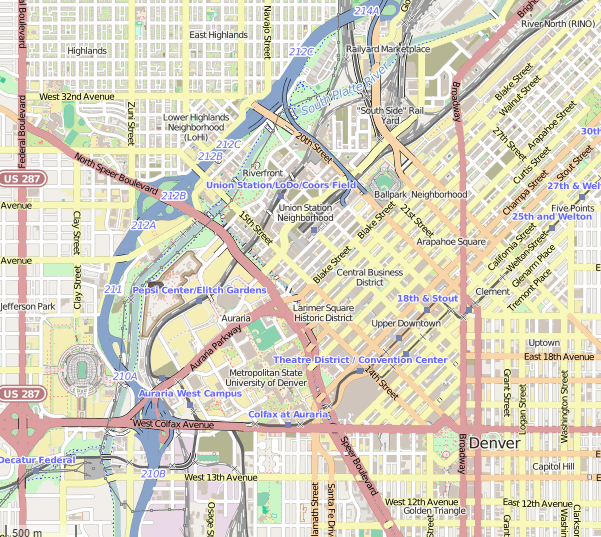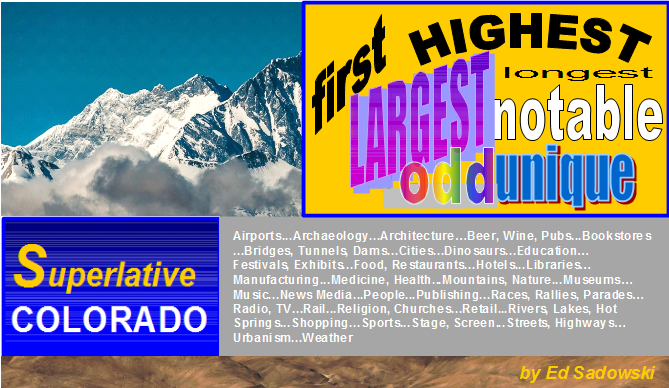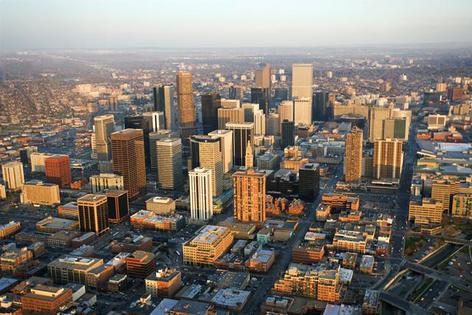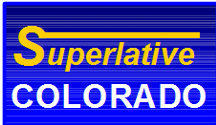Map: © OpenStreetMap contributors
Another Ed Sadowski creation
ED SADOWSKI
GOVERNMENT
Airports...Archaeology...Architecture...Art...Beer, Wine, Pubs... Bookstores...Bridges, Tunnels, Dams...Churches, Religion... Cities... Dinosaurs... Education...Events, Festivals...Food, Restaurants..Hotels... Libraries... Manufaturing...Health, Medicine...Mountains, Nature... Museums... Music...News media...People...Publishing...Races, Rallies, Parades...Radio, TV...Rail transit...Retail...Rivers, Lakes, Hot Springs...Sports...Stage, Screen...Streets, Highways, Infrastructure... Urbanism...Weather, Climate
Downtown
Denver
GOVERNMENT
Colorado State Capitol Bldg.
Denver City & County Bldg.
Denver Mint
Colorado State Capitol Building //////////////////////
E. Colfax Ave. and Lincoln St.
The State Capitol’s superlatives embody its architecture as well as the political events significant to those who have worked in the legislative chambers of the building.
The capitol is the world’s only building with a one-of-a-kind and priceless red marble whose only location was quarried in its entirety in Colorado. The Capitol became the first Capitol in the nation to obtain a prestigious certification for Leadership in Energy and Environmental Design for Existing Buildings for energy efficiency upgrades made. The Capitol also became the first building in the country to receive the US Green Building Council’s LEED certification for Existing Buildings Operations and Maintenance.
The Capitol was built from Colorado white granite in the 1890s, its design reminiscent of the nation’s capitol. It sits slightly higher than the rest of downtown, with the fifteenth step of the west entrance marking the city’s official elevation, with the engraved words “One Mile Above Sea Level.”
In 1893 Colorado gave women the right to vote, the first time in history that women’s suffrage was granted through a popular vote. The very next year voters sent three women to the state House of Representatives. They were the first women elected to any state legislative body in the world. Now Colorado leads the nation with women making up 42% of our state legislature.
Denver City & County Bldg. ////////////////////////////
W. 14th and Bannock Street
A building graced with superlatives, the Denver City and County Building (courthouse and city hall) has the world’s largest doors in an office or residential building: installed in 1932 when the City and County Building was finished, the doors at the front main entrance are 26 feet high, 13 feet wide, and made of cast bronze weighing 31½ tons.
The massive Neoclassical Revival civic structure occupies an entire city block, in a modified Roman-style design. The curved front is colonnaded with Doric columns that rival the largest ever erected in Greece or Rome. The lavish interior finishes include Colorado marble. In the main lobby, the 19-foot-columns are the tallest travertine columns in the world. (Travertine is a compact form of calcium carbonate, a naturally-formed substance deposited from solutions in ground or surface waters, used as a facing material in construction.)
Latter Perry Mason TV episodes were filmed here. At one time this building laid claim to the world’s largest display of Christmas lights. Displaying Christmas lights outdoors on a grand scale was pioneered in 1919 in the adjacent Denver Civic Center and expanded to the City and County Building. By the late 1920s Denver was called the “Christmas Capital of the World.” In 1945 NBC broadcast a tribute to Denver’s creation of the beautiful holiday tradition of Christmas lights.
The Denver Mint /////////////////////////////////////////////
W. Colfax Ave. and Delaware St.
The Denver Mint is the single largest producer of coins in the world, striking over 10 billion coins yearly, with the small D below the date. The Mint is also the largest storehouse of US gold bullion after Fort Knox in Kentucky.
A private mint was built at 16th and Market streets in 1860 to provide a medium of exchange from gold miners’ gold dust and bullion. A federal mint was established in Denver in 1863, and the present facility was constructed in 1906, an Italian Renaissance style building modeled after a Florentine palace. The congressional bill to create a US mint was signed by President Lincoln in 1862, but it would be 43 years before the first coin of the Denver Mint was actually struck. In that first year, the Denver Mint produced 167 million and silver coins, totaling $27 million face value, the most first-year production of any branch of the US mint in history.
Dies for US coins are also fabricated here, as well as in the Philadelphia Mint. The Mint offers free tours that show high-speed presses spitting out 50 million coins daily, and also has a small museum on the history of money. Available for sale are mint sets and commemorative coins.



